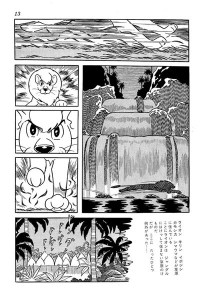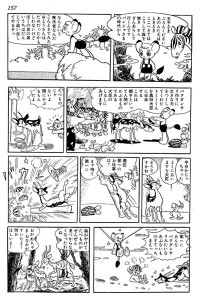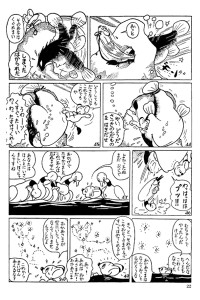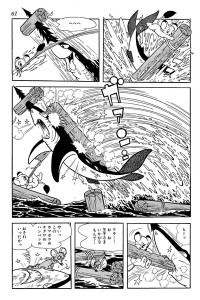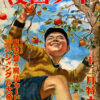Jungle Emperor [aka Kimba] (Manga)
Also known as ジャングル大帝 (Junguru Taitei)
| English Title: | Jungle Emperor |
| In English? | No |
| Japanese Title: | ジャングル大帝 Junguru Taitei |
| Type: | Ongoing Serial |
| Original run: | 1950/11 – 1954/04 |
| Published in: | Manga Shonen 漫画少年 |
| Published by: | Gakudosha |
| Volumes: | 3 MT-001 | MT-002 | MT-003 |
Arguably Tezuka’s second-most well-known series, after Astro Boy (1952-68), Jungle Emperor (1950-54) was originally published as a serial in Manga Shonen between November 1950 and April 1954. Also widely known as Kimba the White Lion, it is one of Tezuka’s earliest serialized (as opposed to all-in-one book) adventures, and its enduring popularity has given rise to several animated television shows.
What it’s about
Tezuka’s story begins with the celebrated hunter Hamegg killing the great white lion Panja and shipping his pregnant mate to a zoo in England. Panja’s son, Leo is soon born on board, and his mother convinces him to escape a life of captivity and sends him overboard. After washing up on shore, Leo is adopted by Kenichi and his uncle and is taught human ways. When he returns to Africa, Leo is shocked by the “law of the jungle” and so he introduces the animals to many of the wonders of human technology, language and civilization. As he grows, Leo learns of the ancestry of the white lions and comes to accept his role as a leader. He eventually marries, and his mate Lyre gives birth to two cubs, Lune and Lukkio. However, when a disease ravages the jungle, Leo must accepts help from his human friends. And so, owing a debt of gratitude, he agrees to join them on their expedition to the mysterious Mt. Moon in search of the wondrous Moonlight stones…
What you should know
Originally planned as a one–shot manga entitled Mitsurin Taitei [密林大帝] – literally “Dense Forest (i.e. “Jungle”) Emperor”, publisher Kenichi Kato convinced the young Osamu Tezuka to expand on his original story idea and offer it as a regular four–page feature in the monthly Manga Shonen. Debuting in November 1950, the newly renamed and more exotic–sounding Junguru Taitei [ジャングル大帝], or “Jungle Emperor”, was an instant hit and was expanded to ten pages the very next month.
Typical of many of Tezuka’s early works, the story rockets along at breakneck speed, cramming in plot device after plot device. As noted Tezkua scholar, Fredrik L. Schodt observes in his book, Dreamland Japan: Writings on Modern Manga, “The printed manga story has gags, comedy, tragedy, allusions to ancient tectonic plates and ‘supercontinents,’ and exotic medical conditions” (1996, p. 273).
Jungle Emperor (1950-54) was always close to Tezuka’s heart, and, despite being over ten years old at the time, when the American television giant National Broadcasting Company (NBC) approached Osamu Tezuka in late 1964 with a request for a new program to follow up on the success of the original 1963 black & white Astro Boy animated television series, Tezuka was only too happy to pitch them a show following the adventures of the heroic white lion.
With the success of the 1965 anime television series, Osamu Tezuka also decided to revisit Jungle Emperor (1950-54) in manga format – only this time for a much younger audience. Not truly a sequel, the Leo the Lion Cub (1965-67) short stories were published in Shogakukan’s Kindergarten & First Grader from April, 1965 to March 1967 and in Third & Fourth Grader from May to November 1966. Although they are not part of the regular Jungle Emperor (1950-54) continuity, they often touch on many of the same themes and events. The artwork and character designs are quite similar to the 1965 anime television series, and they include some of the stories not drawn directly or adapted from the original Jungle Emperor (1950-54) manga.
However, despite boosting its profile, it’s fortunate the Jungle Emperor manga survived the 1965 anime television series at all. This is because a large portion of the original artwork was lost during production in the early 1960’s. While working on character designs for the show, one of the studio staff members “borrowed” the original artwork without permission and then died unexpectedly of alcohol poisoning. In a panic, Tezuka rushed to the man’s apartment, but not before the authorities had cleared out the place – including his artwork. Given the technological limitations at the time, back-up printing plates were prohibitively expensive, so it seemed it seemed lost forever.
So, when Kodansha decided to publish the Osamu Tezuka Complete Manga Works Edition in 1977, there was no choice but to redraw a significant part of the series for publication. Given the difficulties of returning to an art style after fifteen (at the time) years, there is some notable shifts in style throughout the series. It also makes it difficult to determine the “definitive” manga version of Jungle Emperor (1950-54). As was common practice for Osamu Tezuka, every time a new edition of his manga was published, he took it as an opportunity to tweak and improve it, often in an attempt to update elements he felt were becoming dated, and Jungle Emperor (1950-54) is certainly no exception. Given the opportunity to redraw a significant portion of the series, certain aspects of the story were changed, expanded, moved around or deleted entirely. A prime example of this can be seen in the sequence of events that occur between Leo jumping overboard and being found washed up on the beach.
In the original version of Jungle Emperor (1950-54), Kutter finds Leo adrift and invites him aboard his raft. When Kutter starts seeing Leo as a meal, the two part company and Leo’s raft sinks. He is then taught to swim by some friendly fish – which comes in handy when a much larger fish attacks him. After defeating the fish, he is again adrift, he sees his mother in the stars, and is then rescued by a passing ship that just happens to be carrying Hamegg, Prof. Plus and Dr. Minus. Onboard, he meets a group of mice who decide to hold a banquet in his honour. While the mice run around gathering food, Hamegg gets the Moonlight stone appraised and draws the attention of Plus and Minus. Disappointed with Leo‘s poor job in catching the mice, the Captain decides to throw Leo overboard but relents and gives him a life-jacket. Leo then washes up on shore and is found by a group of children that includes Mary, Pierre, Kenichi, Albert, and others.
In the redrawn and revised (1977) portion of Jungle Emperor, the sequence is quite different. Kutter still finds Leo adrift, invites him aboard the raft and then parts company with him when hunger begins to set it. Floating along, he sees his mother in the stars and is then rescued from his small raft by the passing ship. He meets the mice, who, after deciding to hold a banquet in his honor, run around and gather food. Disappointed with Leo‘s poor job in catching the mice, the Captain decides to throw Leo overboard but relents and sends him on his way on a raft. One of the mice, Jacques, jumps overboard and joins Leo on the raft and the two are soon attacked by a large “saw-tooth” shark. After Leo defeats him, with his dying breath the shark offers the pair the use of the remoras on his belly. With the aid of the remoras, Leo and Jacques follow a trail of butterflies, but when the remoras leave, the two are at the mercy of the waves. Washing up on shore, they are discovered by Mary and Pierre – who are out for a joy-ride in Pierre’s car.
Given the re-ordered sequence of events, it is difficult to match the chapters of the final (1977) version published in Kodansha’s Osamu Tezuka Complete Manga Works Edition with the original publication order. Luckily, given advances in digital technology, the original Manga Shonen edition was restored from secondary sources and republished in 2009.
The Jungle Emperor (1950-54) manga is also notable for its controversial depiction of African natives – something which has arguably held up its publication in an English language edition for many years. Despite Tezuka’s humanist views and the overall anti-racist sentiment of his works, he was still very much a product of his times. As was common practice at the time, the African natives in Jungle Emperor (1950-54) are largely racist caricatures with ink-black skin and overly large lips. However, since retroactive politically-correct edits to his works impinge on Tezuka’s artistic rights, Tezuka Productions has instead opted to include an explanatory message in all Tezuka manga published in any language worldwide.


